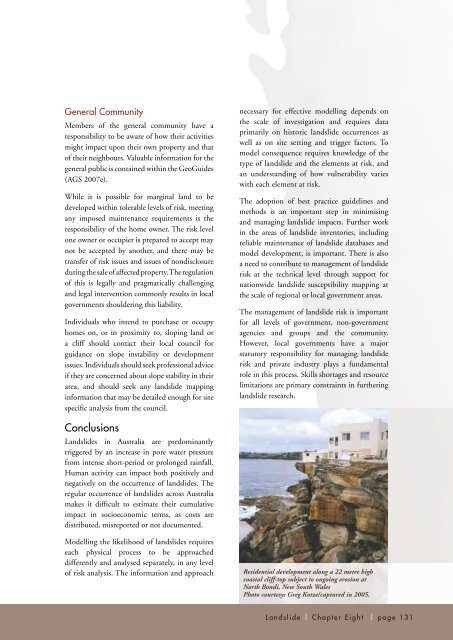Landslide - Geoscience Australia
Landslide - Geoscience Australia
Landslide - Geoscience Australia
Create successful ePaper yourself
Turn your PDF publications into a flip-book with our unique Google optimized e-Paper software.
General Community<br />
Members of the general community have a<br />
responsibility to be aware of how their activities<br />
might impact upon their own property and that<br />
of their neighbours. Valuable information for the<br />
general public is contained within the GeoGuides<br />
(AGS 2007e).<br />
While it is possible for marginal land to be<br />
developed within tolerable levels of risk, meeting<br />
any imposed maintenance requirements is the<br />
responsibility of the home owner. The risk level<br />
one owner or occupier is prepared to accept may<br />
not be accepted by another, and there may be<br />
transfer of risk issues and issues of nondisclosure<br />
during the sale of affected property. The regulation<br />
of this is legally and pragmatically challenging<br />
and legal intervention commonly results in local<br />
governments shouldering this liability.<br />
Individuals who intend to purchase or occupy<br />
homes on, or in proximity to, sloping land or<br />
a cliff should contact their local council for<br />
guidance on slope instability or development<br />
issues. Individuals should seek professional advice<br />
if they are concerned about slope stability in their<br />
area, and should seek any landslide mapping<br />
information that may be detailed enough for site<br />
specific analysis from the council.<br />
necessary for effective modelling depends on<br />
the scale of investigation and requires data<br />
primarily on historic landslide occurrences as<br />
well as on site setting and trigger factors. To<br />
model consequence requires knowledge of the<br />
type of landslide and the elements at risk, and<br />
an understanding of how vulnerability varies<br />
with each element at risk.<br />
The adoption of best practice guidelines and<br />
methods is an important step in minimising<br />
and managing landslide impacts. Further work<br />
in the areas of landslide inventories, including<br />
reliable maintenance of landslide databases and<br />
model development, is important. There is also<br />
a need to contribute to management of landslide<br />
risk at the technical level through support for<br />
nationwide landslide susceptibility mapping at<br />
the scale of regional or local government areas.<br />
The management of landslide risk is important<br />
for all levels of government, non-government<br />
agencies and groups and the community.<br />
However, local governments have a major<br />
statutory responsibility for managing landslide<br />
risk and private industry plays a fundamental<br />
role in this process. Skills shortages and resource<br />
limitations are primary constraints in furthering<br />
landslide research.<br />
Conclusions<br />
<strong>Landslide</strong>s in <strong>Australia</strong> are predominantly<br />
triggered by an increase in pore water pressure<br />
from intense short-period or prolonged rainfall.<br />
Human activity can impact both positively and<br />
negatively on the occurrence of landslides. The<br />
regular occurrence of landslides across <strong>Australia</strong><br />
makes it difficult to estimate their cumulative<br />
impact in socioeconomic terms, as costs are<br />
distributed, misreported or not documented.<br />
Modelling the likelihood of landslides requires<br />
each physical process to be approached<br />
differently and analysed separately, in any level<br />
of risk analysis. The information and approach<br />
Residential development along a 22 metre high<br />
coastal cliff-top subject to ongoing erosion at<br />
North Bondi, New South Wales<br />
Photo courtesy: Greg Kotze/captured in 2005.<br />
<strong>Landslide</strong> | Chapter Eight | page 131

















